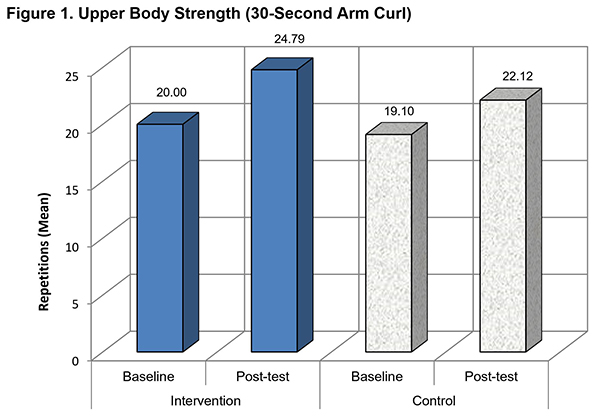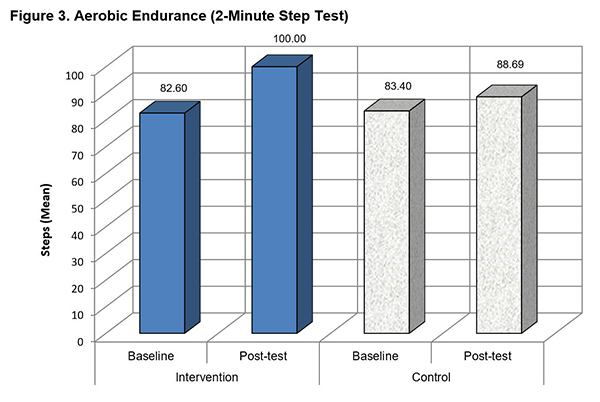Seguin-Fowler RA, Grocke M, Graham ML, Tarabochia D, Sriram U, Eldridge GD. (2021). Effects of StrongPeople Strong Bodies on functional fitness: A community-based randomized trial. Translational journal of the American College of Sports Medicine, 6 (4), e000178.
Program Synopsis
Designed to promote physical activity among adults aged 50 and older in rural communities, this community- and home-based intervention includes twice-weekly strength training classes and optional once-a-week exercises at home. The study showed an improvement in physical fitness.
Program Highlights
Program Materials
Preview and order the materials from the developer
Featured Profile
Learn more about this program and the developer who created it
Program Scores
The Need
U.S. adults in rural areas are less likely to meet recommended guidelines for adequate physical activity than adults in urban areas. Exercise can contribute to a healthy weight and reduce the risks of health-related conditions associated with overweight and obesity (e.g., heart disease, stroke, type 2 diabetes, and certain types of cancer). Physical activity guidelines suggest that older adults engage in muscle-strengthening activities at least 2 days each week to improve muscle strength and overall health. Programs are needed in rural areas to help older adults meet physical activity recommendations.
The Program
StrongPeople Strong Bodies is a community- and home-based intervention designed to promote physical activity among adults aged 50 and older. The intervention was developed from previous strength training research with older adults. The program components are as follows:
-- Training on the intervention for class leaders: Experienced health promotion class leaders (affiliated with a non-profit organization, have current CPR training, and have the appropriate educational and training background) attend a 1-day in-person training (now available online) about the intervention. They learn strength training techniques for older adults, including ways to safely increase exercise intensity over time.
-- Strength training classes: Over a 12-week period, participants attend twice-weekly strength training classes led by trained class leaders. Each 1-hour class includes a warm-up (walking/marching); cool-down (stretching/flexibility); and three sets of eight repetitions of a wide leg squat, standing leg curl, knee extension, side hip raise, bicep curl, overhead press, and bent forward fly exercises. All strength-based exercises use no weights or free weights (e.g., dumbbells, adjustable ankle weights). Participants are encouraged to complete the exercises at home at least once a week.
Community Preventive Services Task Force Finding
 This program uses an intervention approach recommended by the Community Preventive Services Task Force: social support interventions in community settings (Physical Activity).
This program uses an intervention approach recommended by the Community Preventive Services Task Force: social support interventions in community settings (Physical Activity).
Time Required
Class leaders participate in a 1-day training and facilitate twice-weekly, 1-hour strength training classes over a 12-week period.
Intended Audience
The intervention is intended for adults aged 50 and older.
Suitable Settings
The program is suitable for implementation in community- and home-based settings.
Required Resources
Required resources to implement the program include the following:
-- StrongPeople Strong Bodies website
For costs associated with this program, click on Contact Program Developer on the Program Materials page.
About the Study
A randomized controlled trial enrolled eligible participants in six rural counties in Montana. Participants in these counties were randomly assigned to the intervention group (n=83) or a wait-list control group (n=84). Eligible participants were aged 50 and older. Individuals were ineligible to participate if they did strength training in the past 12 months, previously participated in the StrongPeople Strong Bodies program, were enrolled or planned to enroll in a healthy lifestyle program, were cognitively impaired, or did not receive authorization from their primary care provider.
Across the intervention and control groups, 78% of participants were female, 91% were non-Hispanic White, 70% were married, and 45% were employed.
The primary outcomes were measured using a series of tests from the Senior Fitness Test administered by trained research personnel. These tests included the arm curl (number of arm curls a woman can do with a 5-pound weight or a man can do with an 8-pound weight in 30 seconds), a measure of upper body strength; the chair stand (number of times one can stand from a seated position in 30 seconds), a measure of lower body strength; and the 2-minute step test (number of times one can raise the right knee to the required height while walking in place), a measure of aerobic endurance. The secondary outcomes measured exercise attitudes and exercise-related social support. Exercise attitudes were assessed using 14 statements about attitudes related to exercise and fitness from Exercise Attitudes and Behaviors: A Survey of Adults Age 50-79. Exercise-related social support from friends was measured using 10 items from the Sallis Social Support for Exercise Survey.
Key Findings

-
Participants in the intervention group had a greater increase in arm curl repetitions than did those in the control group (p=.01).

-
Participants in the intervention group had a greater increase in chair stand repetitions than did those in the control group (p<.01).

-
Participants in the intervention group had a greater increase in steps than did those in the control group (p<.001).
Additional Findings
-
Exercise attitudes improved in the intervention group and worsened in the control group (p<.001).
-
Exercise-related social support from friends improved in the intervention group and worsened in the control group (p<.01).


